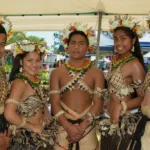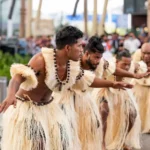Traditional Attire in Micronesia: A Tapestry of Tradition and Culture
The Federated States of Micronesia, an archipelago of over 600 islands in the Pacific Ocean, is home to diverse cultures and traditions. Among these is the region’s distinctive traditional clothing, which reflects the islands’ rich history, environment, and cultural practices. Traditional clothing in Micronesia serves as a marker of identity, status, and community ties, blending practicality with artistry.
Historical Overview of Micronesian Attire
Historically, traditional clothing in Micronesia was heavily influenced by the tropical climate and the availability of natural resources. Early garments were made using materials such as pandanus leaves, hibiscus bark, coconut fibers, and shells. These natural resources were expertly woven, dyed, and crafted into garments that were functional yet symbolic.
Traditional attire often varied across the different islands, reflecting the unique customs and practices of each community. Clothing was not merely utilitarian but also conveyed social and cultural significance, marking occasions such as rituals, marriages, and communal gatherings.
Key Elements of Traditional Clothing
👕 Men’s Attire
- Loincloths: A common garment for men, loincloths were made from finely woven hibiscus or pandanus fibers. These were lightweight and practical for the warm climate.
- Headgear: Men often wore simple yet striking headbands or crowns crafted from leaves, shells, or feathers, symbolizing status and achievements.
- Body Paint: Natural pigments were used to adorn the body, often for ceremonial purposes or as a form of artistic expression.
👗 Women’s Attire
- Grass Skirts: Women’s traditional clothing prominently featured skirts woven from pandanus leaves or hibiscus fibers. These skirts were dyed in vibrant colors for special occasions.
- Wraps and Shawls: Some islands incorporated bark cloth into women’s attire, creating elegant wraps and shawls for ceremonial events.
- Floral Adornments: Women often wore garlands of flowers, adding a touch of natural beauty and signifying femininity and grace.
🌺 Shared Accessories
- Shell Jewelry: Necklaces, bracelets, and anklets made from shells, beads, and bones were universal adornments, symbolizing the islands’ deep connection to the sea.
- Tattoos: Tattoos held significant cultural meaning, denoting social status, achievements, or spiritual beliefs.

What is the Traditional Clothing in Micronesia?
Traditional clothing in Micronesia varies across its islands, each adding unique elements to the overall cultural fabric. Here are some examples of iconic attire:
See also Traditional clothing in Nauru
Traditional clothing in NauruYapese Traditional Attire
- Women: Yapese women traditionally wear colorful striped loincloths and grass skirts, known as Tibaw. These are crafted from natural materials like banana fiber and hibiscus bark, which are manually hand-woven into intricate patterns.
- Men: The traditional loincloth, called “Du”, is a hallmark of Yapese male attire. It comes in various colors such as blue, white, red, or a combination of these, reflecting rank or ceremonial purpose.
Pohnpei Island Clothing
- Women: On Pohnpei, women often wear skirts made from banana fibers, dyed with natural pigments to create bold patterns. During ceremonies, they adorn themselves with beaded necklaces and flower garlands.
- Men: Men wear a simple loincloth, but ceremonial events call for elaborate designs often featuring woven pandanus leaves.
Chuukese Styles
- Women: Chuukese women are known for their lavalavas (sarongs), which are brightly colored and adorned with traditional motifs.
- Men: Similar to other islands, men wear loincloths, but during dances or festivals, they may accessorize with shell necklaces and feathered headpieces.
The Role of Natural Materials in Traditional Clothing
Micronesia’s clothing traditions heavily rely on the natural environment. Islanders skillfully utilize resources like banana fiber, pandanus leaves, hibiscus bark, and coconut fiber to craft their garments. These materials are chosen not only for their availability but also for their comfort in the tropical climate.
The crafting process is as significant as the attire itself, involving:
- Hand-weaving techniques passed down through generations.
- Natural dyes derived from plants, roots, and minerals to create vibrant hues.
- Intricate patterns symbolizing clan affiliation, social status, or spiritual beliefs.
Regional Variations in Traditional Clothing
Yap Region
Known for its elaborate use of banana fiber and hibiscus bark, Yap’s traditional clothing stands out for its durability and elegance. Women’s skirts often include pandanus leaf overlays for ceremonial events.
Kosrae Region
In Kosrae, women traditionally wore woven skirts with floral designs, while men donned simple loincloths. This island emphasizes the use of floral accessories such as crown-like headpieces for formal occasions.
See also Traditional clothing in Marshall Islands
Traditional clothing in Marshall IslandsPalau Region
Palauan clothing often features shell jewelry and feather adornments, showcasing the islanders’ maritime connection. Women wear skirts called “Uruchel,” made from hibiscus bark, and men wear a loincloth known as “Hika”.
Traditional Clothing in Ceremonial Contexts
Traditional clothing is most prominently displayed during cultural ceremonies, festivals, and important life events. These occasions highlight the artistry and cultural pride of the Micronesian people:
- Dances and Performances: Dancers wear traditional attire, including grass skirts and shell jewelry, to perform stories and rituals passed down through generations.
- Weddings: Bridal garments often incorporate elaborate patterns and adornments, symbolizing unity and prosperity.
- Community Gatherings: Festivals provide an opportunity for individuals to showcase traditional attire, strengthening cultural identity and community bonds.
Challenges and Preservation Efforts
The shift toward Western clothing in daily life poses challenges to the preservation of Micronesian traditional attire. However, several initiatives aim to safeguard this cultural heritage:
- Cultural Workshops: Artisans teach traditional weaving, dyeing, and crafting techniques to younger generations.
- Museums and Exhibits: Cultural centers showcase traditional clothing, educating visitors and locals about its significance.
- Festivals and Competitions: Events celebrating traditional attire foster pride and encourage its continued use in ceremonial contexts.
The Enduring Legacy of Micronesian Clothing
Traditional clothing in Micronesia is more than a relic of the past; it is a vibrant expression of identity, artistry, and resilience. By honoring and preserving these garments, the people of Micronesia ensure their cultural heritage remains alive for future generations.
From the practical loincloths and grass skirts to the intricate shell jewelry and body art, Micronesian traditional clothing weaves a story of connection—to nature, community, and history.
